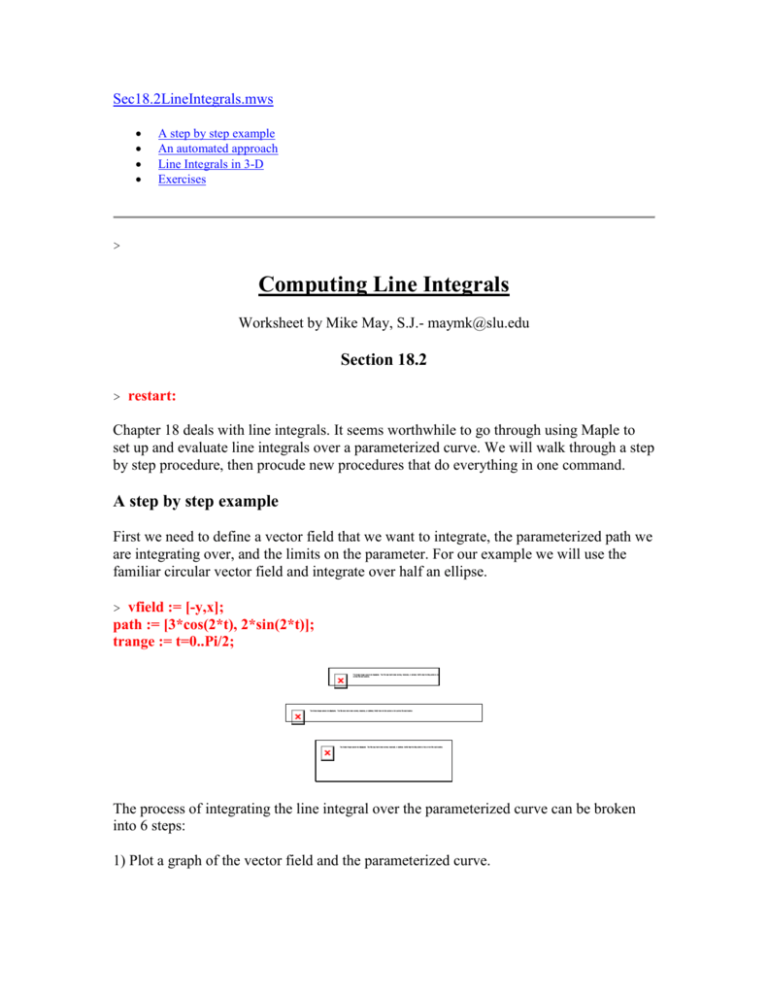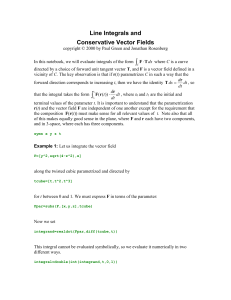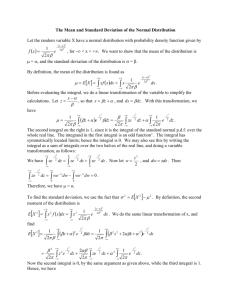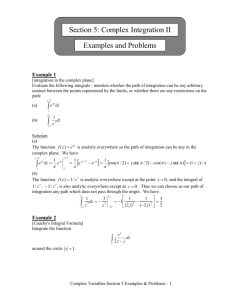Automate.LineIntegrals
advertisement

Sec18.2LineIntegrals.mws
A step by step example
An automated approach
Line Integrals in 3-D
Exercises
>
Computing Line Integrals
Worksheet by Mike May, S.J.- maymk@slu.edu
Section 18.2
>
restart:
Chapter 18 deals with line integrals. It seems worthwhile to go through using Maple to
set up and evaluate line integrals over a parameterized curve. We will walk through a step
by step procedure, then procude new procedures that do everything in one command.
A step by step example
First we need to define a vector field that we want to integrate, the parameterized path we
are integrating over, and the limits on the parameter. For our example we will use the
familiar circular vector field and integrate over half an ellipse.
>
vfield := [-y,x];
path := [3*cos(2*t), 2*sin(2*t)];
trange := t=0..Pi/2;
The process of integrating the line integral over the parameterized curve can be broken
into 6 steps:
1) Plot a graph of the vector field and the parameterized curve.
2) Set up the line integral with the integrand being the dot product of the vector field and
the derivative of the parameterized path.
3) Substitute the parameterization of the path into the field to make the field a vector
valued function of the parameter.
4) Take the derivative of the path with respect to the parameter.
5) Evaluate the dot product and simplify. This reduces the problem to an integral over an
interval.
6) Evaluate the integral.
We are ready to walk through the steps one at a time. As we work through the example
with Maple, you should make sure that you can also do each step by hand.
The first step is to look at a graph of the vector field and the parameterized curve.
>
vfieldplot := plots[fieldplot](vfield,x=-5..5,y=-5..5, grid=[7,7]):
parampath := plot([op(path),trange]):
plots[display]({vfieldplot, parampath});
The next step is to set up the line integral
>
Int((vfield*Diff(path,t)), trange);
The third step is to replace x and y and the vector field with the parameterizations of x
and y at the appropriate point on the path.
>
paramfield := [subs(x=path[1],y=path[2], vfield[1]),
subs(x=path[1],y=path[2], vfield[2])]:
print(`the funtion on the path is `, paramfield);
print(Int((paramfield*Diff(path,t)), trange));
The fourth step is to take the derivative of the parameterized path.
>
dpath := diff(path, t):
print(`the derivative of the path is `, diff(path, t));
print(Int((paramfield*dpath), trange));
The fifth step is to evaluate the dot product in the integrand and simplify.
>
integrand := simplify(linalg[dotprod](paramfield, dpath, orthogonal)):
print(`The integrand is `, integrand);
print(Int(integrand, trange));
Which we now evaluate the integral and evaluate the result numerically if needed.
>
intval := int(integrand, trange);
evalf(intval);
>
An automated approach
For convenience we block the code into two procedures we can use, one for plotting, and
one for setting up the integral and evaluating. This allows us to modify the problem with
a minimal amount of work.
>
pathplot := proc(vecfield, path, trange, xrange, yrange)
local vfieldplot, parampath;
vfieldplot := plots[fieldplot](vecfield,xrange,yrange, grid=[7,7]):
parampath := plot([op(path),trange]):
plots[display]({vfieldplot, parampath});
end:
lineintegral:= proc(vecfield, path, trange)
local intval, paramfield, dpath, integrand;
print(`the vector field is `, vecfield);
print(`the path is `, path, ` with `, trange);
print(Int((vecfield*Diff(path,t)), trange));
paramfield := [subs(x=path[1],y=path[2], vecfield[1]),
subs(x=path[1],y=path[2], vecfield[2])];
print(`the funtion on the path is `, paramfield);
print(Int((paramfield*Diff(path,t)), trange));
dpath := diff(path, t);
print(`the derivative of the path is `, diff(path, t));
print(Int((paramfield*dpath), trange));
integrand := simplify(linalg[dotprod](paramfield, dpath, orthogonal));
print(`The integrand is `, integrand);
print(Int(integrand, trange));
intval := int(integrand, trange);
print(`the integral is `, intval);
print(evalf(intval));
end:
Thus, we can get the results by entering the vectorfield and path and executing the two
commands.
>
vfield := [-y,x];
path := [1+3*cos(t), -4+2*sin(t)];
trange := t=0..Pi;
pathplot(vfield, path, trange, x=-5..5, y=-5..5);
lineintegral(vfield, path, trange);
>
Line Integrals in 3-D
If the vector field is in three dimensions, we need to slightly modify the lineinegral
command. In that case we will not plot the curve.
>
lineintegral3d:= proc(vecfield, path, trange)
local intval, paramfield, dpath, integrand;
print(`the vector field `, vecfield);
print(`the path `, path, ` with `, trange);
print(Int((vecfield*Diff(path,t)), trange));
paramfield := [subs(x=path[1],y=path[2],z=path[3], vecfield[1]),
subs(x=path[1],y=path[2],z=path[3], vecfield[2]),
subs(x=path[1],y=path[2],z=path[3], vecfield[3])];
print(`the funtion on the path is `, paramfield);
print(Int((paramfield*Diff(path,t)), trange));
dpath := diff(path, t);
print(`the derivative of the path is `, diff(path, t));
print(Int((paramfield*dpath), trange));
integrand := simplify(linalg[dotprod](paramfield, dpath, orthogonal));
print(`The integrand is `, integrand);
print(Int(integrand, trange));
intval := int(integrand, trange);
print(`the integral is `, intval);
print(evalf(intval));
end:
Using this command we redo example 4 from the book.
>
vfield := [x, z, -x*y];
path := [cos(t), sin(t), 2*t];
trange := t=0..3*Pi;
lineintegral3d(vfield, path, trange);
>
Exercises
1) Evaluate the line integral where F = [ln(y), ln(x)] and C is the curve given
parametrically by [2t, t^2] with t=2..4..
>
2) Evaluate the line integral where F = [2y, -sin(y)] and C is the unit circle traced in a
counterclockwise directions from the point (1, 0).
>
3) Evaluate the line integral where F = e^x i + e^y j and C is the part of the ellipse x^2 +
4y^2 = 4 from the point (0, 1) to the point (2, 0) in a clockwise direction.
>
4) Evaluate the line integral where F = -y i + x j + 5 k and C is the helix [cos(t), sin(t) t]
for t=0..4Pi.
>
>






